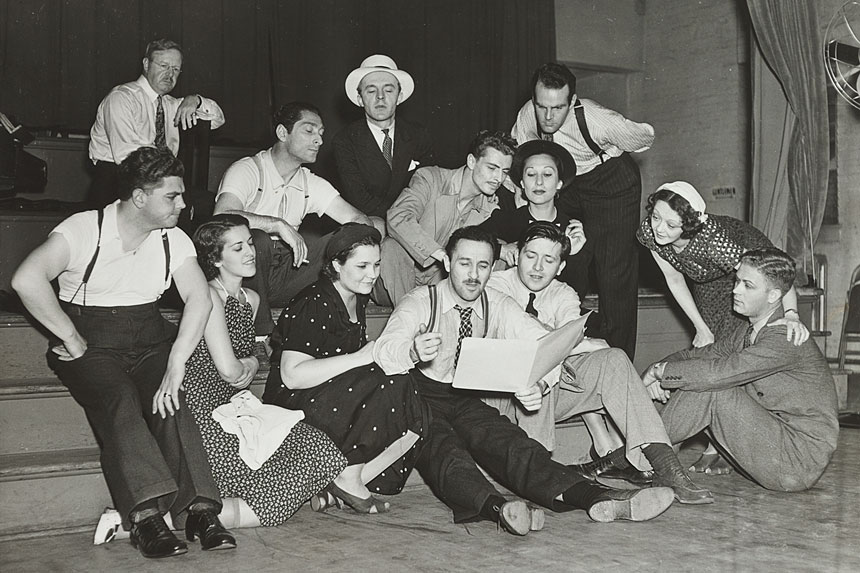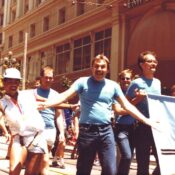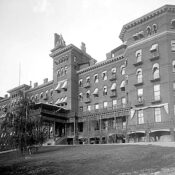When Vassar College drama professor Hallie Flanagan was called to Washington, D.C., on May 16, 1935, she was not expecting to be put in charge of the first American national theater. Yet somehow, she found herself in the dingy office of Works Progress Administrator Harry Hopkins, discussing plans to save the livelihoods of performers across the country.

Hallie Flanagan lived her entire life in educational theater. Whether it was as a student at Grinnell College, as a professor at Vassar, or as a Guggenheim Fellow in Europe, she saw the stage as a place for everyone to learn and grow. To Flanagan, producing theater was a valuable end in and of itself.
Flanagan hadn’t expected her new responsibilities, but she embraced them wholeheartedly. It was her chance to realize a dream she’d long been piecing together: a theater for the people.
Prelude
Flanagan’s passion for performance started in her family’s living room. What began as a family talent show put on each weekend by her father soon became Flanagan’s personal playhouse. As a teenager, she drew inspiration from Grinnell’s new local theater, organizing shows and writing scripts for her siblings to perform under her direction. Hallie’s father, Fred, encouraged her ambition, taking pride in her charisma and natural talent for storytelling. Hallie’s mother, Louisa, was a bit more reserved.
“Hallie’s childhood taught her two very different sets of values,” Flanagan’s stepdaughter, Joanne Bentley, wrote in her book Hallie Flanagan: A Life in the Theatre. “Her father had made her feel she was special and could accomplish anything she set her mind to. Her mother had made her feel that others’ needs mattered most.” Bentley added that Fred’s confidence in Hallie helped her create her life, but it was her mother, Louisa, who cemented her moral code.
When Flanagan attended Grinnell in 1907, university president John Main broadened her sense of duty to include the entire public. He valued civic responsibility strongly, emphasizing it in every aspect of the college culture. Flanagan took this message to heart and threw herself into campus participation — a dress rehearsal of what her sense of duty would look like later in life.
Flanagan flew through her undergraduate years with verve, double majoring in philosophy and German, all while acting in the drama club, heading the Literary Society, and editing for the yearbook. Though her momentum slowed after college, the death of her husband saw her back at Grinnell a few years later, this time as a professor teaching drama.
Rising Action
After half a decade teaching at Grinnell and formative experiences as both student and director in George Pierce Baker’s famed 47 Workshop, Flanagan moved on to Vassar College in New York. Officially the Director of English Speech (Vassar did not have a drama department at the time), Flanagan taught for a year before she was awarded the Guggenheim Fellowship, which allowed her to tour and research theater across Europe. When she returned in 1927, she founded the Vassar Experimental Theatre and began putting on shows.
Flanagan’s vision for the Vassar Experimental Theatre was based on her time as a Guggenheim Fellow — particularly her encounters with the Russian theater. She was drawn to the way Russian theater addressed serious topics and created unity between the audience and the performers.
“The revolution ripped the Russian stage wide open,” Flanagan wrote in her book Shifting Scenes of the Modern European Theatre. “It gave no drama on its own terms. Tear down the curtain — no more lurking behind curtains in life or art. Out with the silly row of lights dividing us — we are no longer amusers and amused.”
Propaganda aside, Flanagan saw potential in the raw, sparse performance style of the Russian theater and sought to re-create it at her own school. Thus, the Vassar Experimental Theatre was born on almost no budget, allowing the ensemble to churn out rapid experimental shows with no real stakes should they fail. “The Vassar Experimental Theatre operated on a small budget, relying scenically chiefly upon light, that we did not pay for labor, and that critical standards were obviously not those of Broadway,” Flanagan recounted in her book Arena. During her time at Vassar, Flanagan focused her directorial efforts on small, loose productions with ambitious, experimental acting.
Enter, Stage Left
Flanagan’s hungry, create-at-any-cost mentality eventually caught the attention of Harry Hopkins, a federal relief administrator and close friend of the Roosevelts.

Hopkins was in charge of relief for the nation’s theater workers, and he envisioned a project with a purpose beyond mere employment. When Hopkins showed Flanagan his early plans, he noted that the project as outlined was “all relief,” with no higher artistic purpose. “Does it have to be?” he asked her. “That’s the question.”
Hopkins wanted to create a mutually beneficial national theater in America, one that gave actors work and gave the public access to culture in return. This aligned perfectly with Flanagan’s experience in educational theater and her fixation on the Russian people’s stage.
Flanagan felt a kinship with Hopkins, a fellow Grinnell graduate and acolyte of John Main. Main had “regarded art, music, and the theatre as necessary and normal expressions of life,” Flanagan wrote in Arena. As such, she was assured in Hopkins’ devotion to keeping the stage alive. Hopkins, similarly, could be sure of Flanagan’s dedication to public service. They were the perfect directorial team to make the Federal Theatre Project a boon not only to down-and-out theater workers but to the public at large.
Climax
Under Flanagan’s guidance, the Federal Theatre Project went from a simple relief plan to a legitimate theatrical movement. The project’s primary goal always remained employment, but Flanagan’s directorial voice meant that every job was in service of an overarching artistic vision.
“While our aim is to put to work thousands of theatre people, our more far-reaching purpose is to organize and support theatrical enterprises so excellent in quality, so low in cost, and so vital to the communities involved that they will be able to continue after federal aid is withdrawn,” John Houseman wrote in the foreword to Arena.
As a relief program first and foremost, the FTP had a unique model. The FTP headquarters were in Washington, D.C., but most of the program was organized through locally operated theatrical leagues, with regional directors appointed in different parts of the country. For example, the Southwest Region included Oklahoma, Arkansas, and Texas, so all sub-groups in those states would report to the Southwest regional director.
“Beyond the FTP’s immediate goals, Hallie Flanagan dreamed of creating a distinctively American national theater, diverse and democratic as the highly centralized theaters of Europe were not, that would express the country’s varied cultural heritage, yet draw people together in shared theatrical experiences,” author Wendy Smith wrote in her essay The Play That Electrified Harlem.

New York City was the largest branch of the FTP, employing so many people that it warranted its own region. A majority of the FTP projects people cite today came out of the NYC branch — most famously Orson Welles’ groundbreaking all-Black production of Macbeth, set in revolutionary Haiti.
Welles wasn’t the only one to produce experimental, subversive content on FTP funding. With Flanagan’s direct endorsement, the FTP became a way for people across the country to voice grievances and share radical information. Two such projects were Revolt of the Beavers, a children’s show about a group of beavers overthrowing their exploitative boss, and Living Newspaper, a series of local and touring plays addressing controversial news topics.
The Reviews Are In
Although Flanagan’s high ambitions were met with hope from actors and theater critics, she received many of the same criticisms lobbed at the Works Progress Administration as a whole: gross overspending of taxpayer money, with the added disgrace of that money going toward alleged Marxist propaganda.
In a 1936 issue of the Post, journalist Garet Garrett wrote a scathing article that linked Flanagan’s interest in Russian theater to Soviet sympathies. After pointing out that Congress had no say in how FTP money was doled out, Garrett denounced Flanagan, Hopkins, and the FTP in its entirety. “It becomes evident that the Federal Theatre, originating within the unemployment-relief motive, ceases to see itself primarily as a relief project,” wrote Garrett. “It sees itself rather as a cultural project. As such, it must comprehend theater as an art, completely; and beyond that, it must comprehend this art as a social force.”

To Garrett, this overreach was the FTP’s greatest crime, but Flanagan saw it as one of the FTP’s highest achievements. “Creating for our citizens a medium for free expression as no other form of government can assure, and offering the people access to the arts and tools of a civilization which they themselves are helping to make, such a theater is at once an illustration and a bulwark of the democratic form of government,” she wrote in Arena.
Flanagan also reasoned that, as devising new works was a necessity for any living theater, and since the taxpayers were paying for the FTP, they should be platforming the common man’s voice. “Any theatre supported by taxes from all the people must be a people’s theatre,” she wrote. If the people wanted to use their theater to voice controversial opinions or criticize those in power, who was she to stop them?
Curtain
The FTP consumed Flanagan’s life between 1936 and 1939, but ultimately, no amount of work could erase its controversial public perception. Congress shut the FTP down in 1939, and its funding was reallocated to other projects within the WPA.
In its short lifespan, the FTP produced around 1,200 shows and employed over 12,000 theater workers. Hollywood notables Arthur Miller, Joseph Cotten, John Houseman, and Orson Welles all got their start at the FTP. The project also helped to maintain niche art forms, like clowns and puppeteers, in a time where they might have otherwise disappeared entirely.
In the conclusion to Arena, Flanagan expressed regret that the FTP never got the chance to be everything she and Hopkins had dreamt it would be, but also hoped that someday an American people’s theater would realize that vision.
“It was “gusty, lusty, bad and good, sad and funny, superbly worth more wit, wisdom and imagination than we could give it,” she wrote. “Its significance lies in pointing to the future. The ten thousand anonymous men and women — the et ceteras and the and-so-forths who did the work, the nobodies who were everybody, the somebodies who believed it — their dreams and deeds were not the end. They were the beginning of a people’s theatre in a country whose greatest plays are still to come.”
Become a Saturday Evening Post member and enjoy unlimited access. Subscribe now



